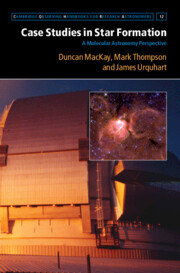Book contents
- Frontmatter
- Dedication
- Contents
- Preface
- List of Acronyms
- Part I Introduction
- Part II Low-Mass Star Formation (LMSF)
- Part III High-Mass Star Formation (HMSF)
- Part IV Ionisation
- Part V Photodissociation
- Part VI External Galaxies
- 16 Extragalactic Surveys: CANON and PHANGS-ALMA
- 17 ST16 and N113 in the Large Magellanic Cloud
- 18 Starburst Galaxy NGC 253
- Appendices
- List of Research Journal Abbreviations
- References
- Chemical Index
- Subject Index
17 - ST16 and N113 in the Large Magellanic Cloud
from Part VI - External Galaxies
Published online by Cambridge University Press: 11 April 2023
- Frontmatter
- Dedication
- Contents
- Preface
- List of Acronyms
- Part I Introduction
- Part II Low-Mass Star Formation (LMSF)
- Part III High-Mass Star Formation (HMSF)
- Part IV Ionisation
- Part V Photodissociation
- Part VI External Galaxies
- 16 Extragalactic Surveys: CANON and PHANGS-ALMA
- 17 ST16 and N113 in the Large Magellanic Cloud
- 18 Starburst Galaxy NGC 253
- Appendices
- List of Research Journal Abbreviations
- References
- Chemical Index
- Subject Index
Summary
Within the Large Magellanic Cloud, a hot core is observed associated with the embedded high-mass YSO (IRAS 05195˗6911), known as ST16. Comparative observations with molecular abundances typical of Galactic hot cores are discussed, as is the evidence for a rotating protostellar envelope and outflow cavity. A second LMC source, the prominent star-formation region N113, shows centrally focused star formation with associated point-like mid-infrared emission, masers, and compact HII regions superimposed on extended emission. Gas and dust appear compressed by a complex structure of ionized gas bubbles (prominent in Hα detections) engendered by massive stars in several young clusters. In both ST16 and N113 low-metallicity sources, warm dust appears to inhibit COMs formation and survival, while reaction routes appear broadly comparable with Galactic models.
- Type
- Chapter
- Information
- Case Studies in Star FormationA Molecular Astronomy Perspective, pp. 267 - 280Publisher: Cambridge University PressPrint publication year: 2023

